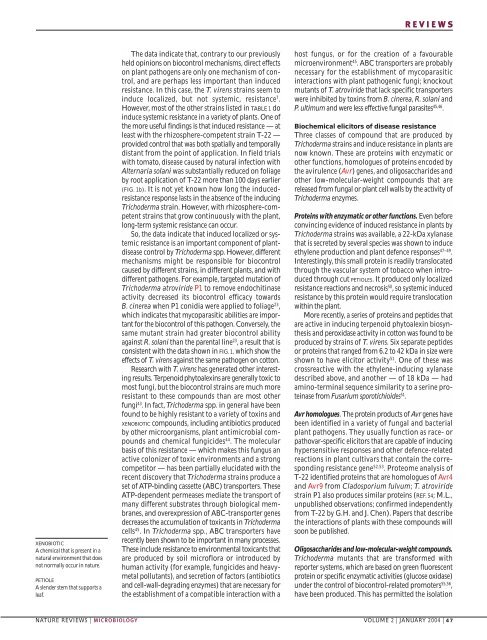trichoderma species - Weizmann Institute of Science
trichoderma species - Weizmann Institute of Science
trichoderma species - Weizmann Institute of Science
You also want an ePaper? Increase the reach of your titles
YUMPU automatically turns print PDFs into web optimized ePapers that Google loves.
REVIEWSXENOBIOTICA chemical that is present in anatural environment that doesnot normally occur in nature.PETIOLEA slender stem that supports aleaf.The data indicate that, contrary to our previouslyheld opinions on biocontrol mechanisms, direct effectson plant pathogens are only one mechanism <strong>of</strong> control,and are perhaps less important than inducedresistance. In this case, the T. virens strains seem toinduce localized, but not systemic, resistance 7 .However, most <strong>of</strong> the other strains listed in TABLE 1 doinduce systemic resistance in a variety <strong>of</strong> plants. One <strong>of</strong>the more useful findings is that induced resistance — atleast with the rhizosphere-competent strain T-22 —provided control that was both spatially and temporallydistant from the point <strong>of</strong> application. In field trialswith tomato, disease caused by natural infection withAlternaria solani was substantially reduced on foliageby root application <strong>of</strong> T-22 more than 100 days earlier(FIG. 1b). It is not yet known how long the inducedresistanceresponse lasts in the absence <strong>of</strong> the inducingTrichoderma strain. However, with rhizosphere-competentstrains that grow continuously with the plant,long-term systemic resistance can occur.So, the data indicate that induced localized or systemicresistance is an important component <strong>of</strong> plantdiseasecontrol by Trichoderma spp. However, differentmechanisms might be responsible for biocontrolcaused by different strains, in different plants, and withdifferent pathogens. For example, targeted mutation <strong>of</strong>Trichoderma atroviride P1 to remove endochitinaseactivity decreased its biocontrol efficacy towardsB. cinerea when P1 conidia were applied to foliage 23 ,which indicates that mycoparasitic abilities are importantfor the biocontrol <strong>of</strong> this pathogen. Conversely, thesame mutant strain had greater biocontrol abilityagainst R. solani than the parental line 23 ,a result that isconsistent with the data shown in FIG. 1, which show theeffects <strong>of</strong> T. virens against the same pathogen on cotton.Research with T. virens has generated other interestingresults. Terpenoid phytoalexins are generally toxic tomost fungi, but the biocontrol strains are much moreresistant to these compounds than are most otherfungi 43 .In fact,Trichoderma spp. in general have beenfound to be highly resistant to a variety <strong>of</strong> toxins andXENOBIOTIC compounds, including antibiotics producedby other microorganisms, plant antimicrobial compoundsand chemical fungicides 44 .The molecularbasis <strong>of</strong> this resistance — which makes this fungus anactive colonizer <strong>of</strong> toxic environments and a strongcompetitor — has been partially elucidated with therecent discovery that Trichoderma strains produce aset<strong>of</strong>ATP-binding cassette (ABC) transporters. TheseATP-dependent permeases mediate the transport <strong>of</strong>many different substrates through biological membranes,and overexpression <strong>of</strong> ABC-transporter genesdecreases the accumulation <strong>of</strong> toxicants in Trichodermacells 45 .In Trichoderma spp., ABC transporters haverecently been shown to be important in many processes.These include resistance to environmental toxicants thatare produced by soil micr<strong>of</strong>lora or introduced byhuman activity (for example, fungicides and heavymetalpollutants), and secretion <strong>of</strong> factors (antibioticsand cell-wall-degrading enzymes) that are necessary forthe establishment <strong>of</strong> a compatible interaction with ahost fungus, or for the creation <strong>of</strong> a favourablemicroenvironment 45 .ABC transporters are probablynecessary for the establishment <strong>of</strong> mycoparasiticinteractions with plant pathogenic fungi; knockoutmutants <strong>of</strong> T. atroviride that lack specific transporterswere inhibited by toxins from B. cinerea, R. solani andP. ultimum and were less effective fungal parasites 45,46 .Biochemical elicitors <strong>of</strong> disease resistanceThree classes <strong>of</strong> compound that are produced byTrichoderma strains and induce resistance in plants arenow known. These are proteins with enzymatic orother functions, homologues <strong>of</strong> proteins encoded bythe avirulence (Avr) genes, and oligosaccharides andother low-molecular-weight compounds that arereleased from fungal or plant cell walls by the activity <strong>of</strong>Trichoderma enzymes.Proteins with enzymatic or other functions. Even beforeconvincing evidence <strong>of</strong> induced resistance in plants byTrichoderma strains was available, a 22-kDa xylanasethat is secreted by several <strong>species</strong> was shown to induceethylene production and plant defence responses 47–49 .Interestingly, this small protein is readily translocatedthrough the vascular system <strong>of</strong> tobacco when introducedthrough cut PETIOLES.It produced only localizedresistance reactions and necrosis 50 , so systemic inducedresistance by this protein would require translocationwithin the plant.More recently, a series <strong>of</strong> proteins and peptides thatareactive in inducing terpenoid phytoalexin biosynthesisand peroxidase activity in cotton was found to beproduced by strains <strong>of</strong> T. virens. Six separate peptidesor proteins that ranged from 6.2 to 42 kDa in size wereshown to have elicitor activity 51 . One <strong>of</strong> these wascrossreactive with the ethylene-inducing xylanasedescribed above, and another — <strong>of</strong> 18 kDa — hadamino-terminal sequence similarity to a serine proteinasefrom Fusarium sporotichioides 51 .Avr homologues.The protein products <strong>of</strong> Avr genes havebeen identified in a variety <strong>of</strong> fungal and bacterialplant pathogens. They usually function as race- orpathovar-specific elicitors that are capable <strong>of</strong> inducinghypersensitive responses and other defence-relatedreactions in plant cultivars that contain the correspondingresistance gene 52,53 .Proteome analysis <strong>of</strong>T-22 identified proteins that are homologues <strong>of</strong> Avr4and Avr9 from Cladosporium fulvum; T. atroviridestrain P1 also produces similar proteins (REF. 54; M.L.,unpublished observations; confirmed independentlyfrom T-22 by G.H. and J. Chen). Papers that describethe interactions <strong>of</strong> plants with these compounds willsoon be published.Oligosaccharides and low-molecular-weight compounds.Trichoderma mutants that are transformed withreporter systems, which are based on green fluorescentprotein or specific enzymatic activities (glucose oxidase)under the control <strong>of</strong> biocontrol-related promoters 55,56 ,have been produced. This has permitted the isolationNATURE REVIEWS | MICROBIOLOGY VOLUME 2 | JANUARY 2004 | 47
















